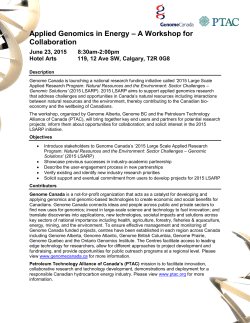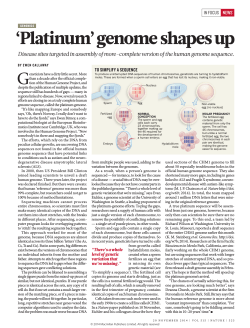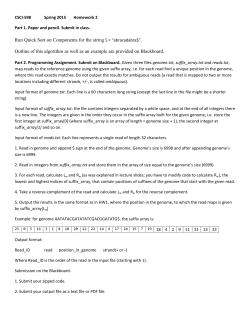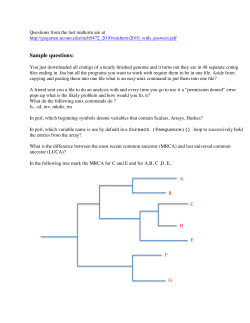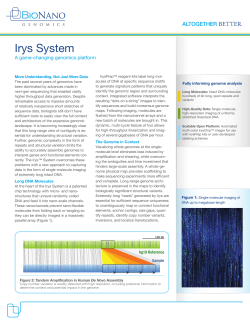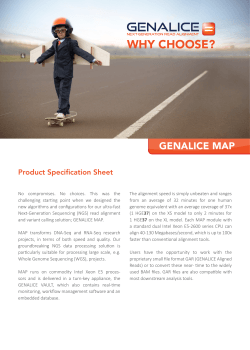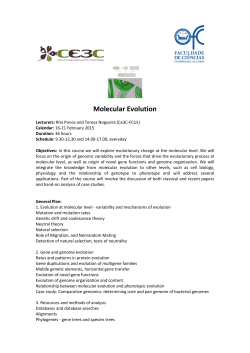
Noncoding RNAs: The Fourth Dimension of the Human Genome
MOJ Proteomics & Bioinformatics Noncoding RNAs: The Fourth Dimension of the Human Genome Editorial Abbreviations: lncRNA: Long non-coding RNA; lincRNA: Long intergenic RNA; miR: Micro RNA; SNP: Single Nucleotide Polymorphism Volume 2 Issue 2 - 2015 Editorial The human genome encoding the three billion letters of DNA alphabet continues to deliver surprises and raise new questions [1,2]. The initial focus of the genome project was on the discovery of gene targets for diagnosis and therapy [3]. Until recently, the knowledge base of the genome largely revolved around three dimensions: DNA, RNA and protein. A vast amount of the human genome once considered Dark Matter or junk DNA has become an area of intense research [4-9]. It is estimated that over 93% of the human genome is transcribed [10]. The role of this huge amount of the transcriptome in biology is however, unclear. This part of the genome, the noncoding RNAs (ncRNAs) can be rightly be considered the fourth dimension of the genome. The ncRNAs comprise the long non-coding RNAs (lncRNAs), the long intergenic RNAs (lincRNAs), endogenous antisense RNAs, the microRNAs (miRs) and pseudogenes-derived lncRNAs [7]. The current version of the GENCODE database (v 22) estimates there to be 25,794 ncRNAs in humans [11,12]. The ncRNAs are crucial in gene regulation exerting their regulatory role at the chromatin, transcriptome and proteome level [13]. The regulation of the target genes by the ncRNAs occurs at the level of RNA and protein stabilization, protein binding and protein translocation or processing [9]. Originally thought to be non-protein coding transcripts, at least some of the ncRNAs now seem to be capable of coding for Open Reading Frames [14,15]. Thus, eventually the terminology non-coding will have to evolve to accurately reflect the differences between the coding and the non-coding nature of the transcriptome. Increasing evidence in the ncRNA field of research is beginning to challenge our current understanding of the human genome. Pseudogene-derived lncRNAs are emerging as key regulators of gene expression and as a reservoir for miRs and endogenous antisense transcripts [16]. In addition, various Genome Wide Association Studies (GWAS) have identified a vast majority of disease-associated Single Nucleotide Polymorphisms (SNPs) which are present at the non-coding intronic or intergenic regions of the genes [17,18]. These regions were neglected in the past because of the focus on the protein coding regions. However, the attention is beginning to shift to this unexplored region of the human genome. Understanding the impact of these SNPs is going to allow us to develop a better understanding of diverse disease-associated phenotypes in the future. The ncRNAs including the miRs are of major interest for novel therapeutics as well as diagnostic biomarker development [4,19,20]. Numerous tools are becoming available to study the ncRNAs [21-26]. A microRNAs miR 222, is being developed as Submit Manuscript | http://medcraveonline.com Ramaswamy Narayanan* Department of Biological Sciences, Charles E. Schmidt College of Science, Florida Atlantic University, USA *Corresponding author: Ramaswamy Narayanan, Department of Biological Sciences, Charles E. Schmidt College of Science, Florida Atlantic University, Boca Raton, FL33431, USA, Tel: 5612972247; Fax: 5612973859; E-Mail: Received: March 21, 2015 | Published: March 28, 2015 a therapeutic for hepatocellular carcinoma [27]. The Federal Drug Agency (FDA) approved its first lncRNA, the Prostate cancer antigen 3 (PCA3) as a urinary biomarker for prostate cancer diagnosis [28]. The miRs because of the stability in body fluids due to the secretome nature involving the exosomes, offer tremendous opportunities for biomarker potential for diagnosis and prognosis for cancer and other diseases [19,29-31]. The ncRNAs are the next frontier in molecular biology. The fruits of research in the ncRNA arena in the next decade are likely to challenge the current dogma in molecular biology. As we begin to understand more about the role of the entire transcriptome in gene regulation, our understanding of biology and function of a gene will achieve greater clarity. This is likely to lead into novel therapy and diagnosis for diverse diseases. Acknowledgements I thank Jeanine Narayanan for editorial assistance. This work was supported in part by the Genomics of Cancer Fund, Florida Atlantic University Foundation. References 1. Lander ES, Linton LM, Birren B, Nusbaum C, Zody MC, et al. (2001) Initial sequencing and analysis of the human genome. Nature 409(6822): 860-921. 2. Venter JC, Adams MD, Myers EW, Li PW, Mural RJ, et al. (2001) The sequence of the human genome. Science 291(5507): 1304-1351. 3. Hopkins AL, Groom CR (2002) The druggable genome. Nat Rev Drug Discov 1(9): 727-730. 4. Martin L, Chang HY (2012) Uncovering the role of genomic “dark matter” in human disease. J Clin Invest 122(5): 1589-1595. 5. Hauptman N, Glavac D (2013) MicroRNAs and long non-coding RNAs: prospects in diagnostics and therapy of cancer. Radiol Oncol 47(4): 311-318. 6. Huang Y, Regazzi R, Cho W (2014) Editorial on “Emerging roles on long noncoding RNAs in neurological diseases and metabolic disorders” Out of Darkness - Long Noncoding RNAs Come of Age. MOJ Proteomics Bioinform 2015, 2(2): 00043 Noncoding RNAs: The Fourth Dimension of the Human Genome Frontiers in Genetics 5 doi: 10.3389/fgene.2014.00388. 7. Wright MW (2014) A short guide to long non-coding RNA gene nomenclature. Hum Genomics 8: 7. 8. Yang G, Lu X, Yuan L (2014) LncRNA: a link between RNA and cancer. Biochim Biophys Acta 1839(11): 1097-1109. 9. Iyer MK, Niknafs YS, Malik R, Singhal U, Sahu A, et al. (2015) The landscape of long noncoding RNAs in the human transcriptome. Nat Genet 47: 199-208. 10. Consortium EP, Birney E, Stamatoyannopoulos JA, Dutta A, Guigo R, et al. (2007) Identification and analysis of functional elements in 1% of the human genome by the ENCODE pilot project. Nature 447(7146): 799-816. 11. Harrow J, Frankish A, Gonzalez JM, Tapanari E, Diekhans M, et al. (2012) GENCODE: the reference human genome annotation for The ENCODE Project. Genome Res 22(9): 1760-1774. 12. Cunningham F, Amode MR, Barrell D, Beal K, Billis K, et al. (2015) Ensembl 2015. Nucleic Acids Res 43(Database issue): D662-D669. 13. Yang G, Lu X, Yuan L (2014) LncRNA: A link between RNA and cancer. Biochimica et Biophysica Acta (BBA) - Gene Regulatory Mechanisms 1839(11): 1097-1109. 14. Delgado A, Chapado MJ, Brandao P, Hamid S, Narayanan R (2015) Atlas of the Open reading Frames in human diseases: Dark matter of the human genome. MOJ Proteomics Bioinform 2(1): 00036. 15. Kageyama Y, Kondo T, Hashimoto Y (2011) Coding vs non-coding: translatability of short ORFs found in putative non-coding transcripts. Biochimie 93(11): 1981-1986. 16. Milligan MJ, Lipovich L (2015) Pseudogene-Derived LncRNAs: Emerging Regulators of Gene Expression. Front Genet 5: 476. 17. Hindorff LA, Sethupathy P, Junkins HA, Ramos EM, Mehta JP, et al. (2009) Potential etiologic and functional implications of genomewide association loci for human diseases and traits. Proc Natl Acad Sci U S A 106(23): 9362-9367. 18. Kellis M, Wold B, Snyder MP, Bernstein BE, Kundaje A, et al. (2014) Defining functional DNA elements in the human genome. Proc Natl Acad Sci U S A 111(17): 6131-6138. 19. Shen J, Stass SA, Jiang F (2013) MicroRNAs as potential biomarkers Copyright: ©2015 Narayanan 2/2 in human solid tumors. Cancer lett 329(2): 125-136. 20. Zarate R, Boni V, Bandres E, Garcia-Foncillas J (2012) MiRNAs and LincRNAs: Could they be considered as biomarkers in colorectal cancer? Int J Mol Sci 13(1): 840-865. 21. Xiao F, Zuo Z, Cai G, Kang S, Gao X, et al. (2009) miRecords: an integrated resource for microRNA-target interactions. Nucleic Acids Res 37(Database issue): D105-D110. 22. Xie B, Ding Q, Han H, Wu D (2013) miRCancer: a microRNA-cancer association database constructed by text mining on literature. Bioinformatics 29(5): 638-644. 23. Jiang Q, Wang Y, Hao Y, Juan L, Teng M, et al. (2009) miR2Disease: a manually curated database for microRNA deregulation in human disease. Nucleic Acids Res 37(Database issue): D98-D104. 24. Mortazavi A, Williams BA, McCue K, Schaeffer L, Wold B (2008) Mapping and quantifying mammalian transcriptomes by RNA-Seq. Nat Methods 5(7): 621-628. 25. Fritah S, Niclou SP, Azuaje F (2014) Databases for lncRNAs: a comparative evaluation of emerging tools. RNA 20(11): 1655-1665. 26. Guffanti A, Simchovitz A, Soreq H (2014) Emerging bioinformatics approaches for analysis of NGS-derived coding and non-coding RNAs in neurodegenerative diseases. Front Cell Neurosci 8: 89. 27. Garofalo M, Quintavalle C, Romano G, Croce CM, Condorelli G (2012) miR221/222 in cancer: their role in tumor progression and response to therapy. Curr Mol Med 12(1): 27-33. 28. Crawford ED, Rove KO, Trabulsi EJ, Qian J, Drewnowska KP, et al. (2012) Diagnostic performance of PCA3 to detect prostate cancer in men with increased prostate specific antigen: a prospective study of 1,962 cases. J Urol 188(5): 1726-1731. 29. Candelario KM, Steindler D (2014) The role of extracellular vesicles in the progression of neurodegenerative disease and cancer. Trends Mol Med 20(7): 368-374. 30. Lujambio A, Lowe SW (2012) The microcosmos of cancer. Nature 482(7385): 347-355. 31. Costa PM, Pedroso de Lima MC (2013) MicroRNAs as Molecular Targets for Cancer Therapy: On the Modulation of MicroRNA Expression. Pharmaceuticals 6(10): 1195-1220. Citation: Narayanan R (2015) Noncoding RNAs: The Fourth Dimension of the Human Genome. MOJ Proteomics BioinformJ 2(2): 00043. DOI: 10.15406/mojpb.2015.02.00043
© Copyright 2025

